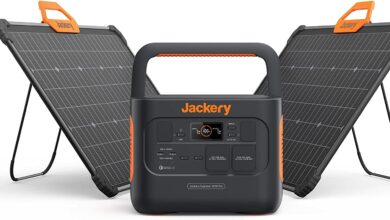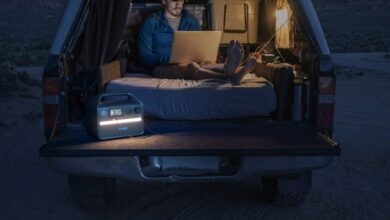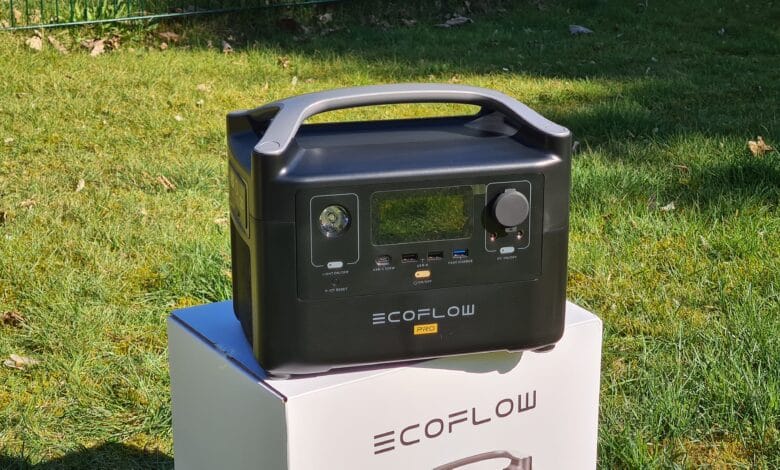
A conventional powerbank is too small for you? Then you should take a look at the market segment of power stations. These are becoming more and more popular among the masses and are slowly but surely replacing the smelly emergency generator with diesel engine. Apart from the non-existent odor and noise pollution, they also offer many other advantages. On the one hand, there is the versatility. No matter if you want to be prepared for the next power outage or if you want to charge your electrical devices in the wilderness. Power stations offer the right solution for many users. With the EcoFlow River Pro we want to take a look at a practical power station today.
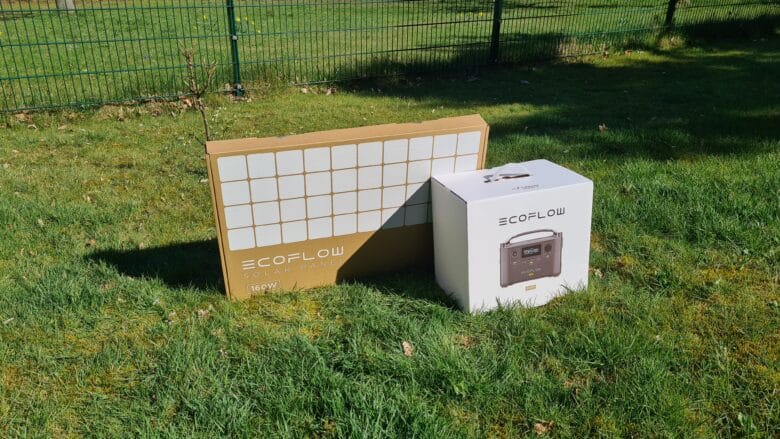
This is already convincing at first glance with a battery capacity of a proud 720 Wh. But that is only one point that is at least theoretically on the credit side. On top of that, the River Pro can offer many different ports, where almost every device from the household should find a place. Last but not least, the manufacturer promises that the power station can be fully charged in just one hour. We wanted to take a closer look at whether the River PRO can deliver what EcoFlow promises in our test. EcoFlow not only sent us the power station itself, but also a matching solar panel with 160 watts of power.
About EcoFlow
Before we get into the River Pro in particular, let’s first take a look at the company behind it. EcoFlow is a relatively young company that was only founded in 2017. Behind the brand are founders who had focused on drone development before EcoFlow came into being. The company owners then discovered their talent for designing power stations when they were tinkering with battery solutions for their own drone technology. The goal here was to fit the largest possible batteries into a case that was as small as possible. What began with drone batteries has now resulted in what is now a whole range of power stations. A few weeks ago, we took a closer look at the EcoFlow DELTA Pro in a test. Whether the manufacturer can also score with its River Pro as a compact sister device, we now take a closer look.





Scope of delivery
Since it is not a cheap piece of technology in view of an MSRP of 749.00 euros, EcoFlow packs its River Pro in a package that quite obviously offers reliable protection for the PowerStation. But of course, it’s the innards that matter.
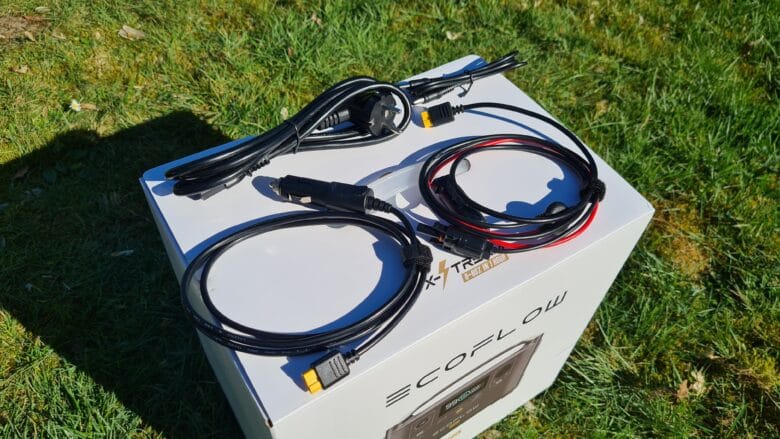
That’s why we immediately took a look at the package contents. Away from the power station itself, the box contains 1x car charging plug with 12 volts, 1x powerful charging cable with 12 volts, 1x DC to DC cable and 1x suitable charging cable for solar panels.
Design and workmanship
Once you put the folding rule to the EcoFlow River Pro, you measure 289 mm x 180 mm x 235 mm. That is really remarkable in view of a battery capacity of an astonishing 720 Wh. The portability not only results from the comparatively compact dimensions, but also from the low weight of only 7.6 kg, which makes for a very convenient use. The competition cannot keep up here. In order to benefit from the compact size, EcoFlow provides its power station with a practical carrying handle, which is located on the upper side.
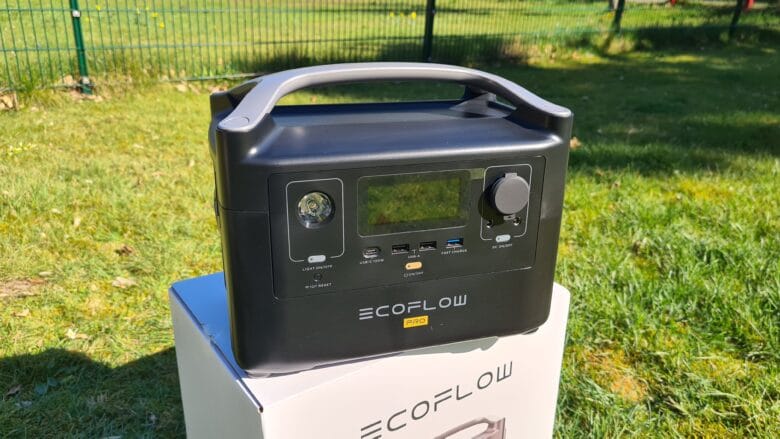
As nice as the handle idea may be, it underscores the River Pro’s rather average choice of materials. The power station is made entirely of plastic. This may be well-made, but we would have liked better material, at least for the carrying handle. At first glance, I assumed that EcoFlow would use resistant aluminum for the handle. Unfortunately, this is not the case. Despite the questionable choice of material, the manufacturer still manages to make the River Pro feel very high-quality. The manufacturer does not make any mistakes in the workmanship.
Many ports
The EcoFlow River Pro scores with many different ports in practice. Every user should be able to find the right input or output here. The manufacturer installs the majority of the ports on the front. This includes 2x USB-A 2.0, 1x USB-A Fast Charge, 1x USB-C (100 W), 2x DC 13.6V/3A and 1x car output 8A. But not only the ports form an eye-catcher on the front of the device.

In addition, EcoFlow places a display here in the center, which outputs the most important information about the PowerStation. To the left of the display is a practical light. EcoFlow distributes the remaining connections over the right and left side of the device. While there are 2x 230 V Schuko sockets on the right side, we find 1x AC in, 1x DC 12V in as well as 1x solar input on the left side. As you can see, the most common devices can undoubtedly be operated on the River Pro without any problems.
The practical test
After the theory comes the practice. And this can look very different with the River Pro. Many will perhaps decide to take the power station with them on vacation thanks to the compact design. In view of the high battery capacity of 720 Wh, it can easily last a long weekend. Of course, it always depends on which devices you want to run with the Powerstation.

Given the ability to output a whopping 600 watts by default, it’s clear that you can easily run multiple devices simultaneously here. If that’s not enough, the so-called X-Boost mode can increase the power even more and output up to 1800 watts. Since you will probably only need this much power in exceptional situations, the normal mode can also be doubled to 1200 watts for a short time.
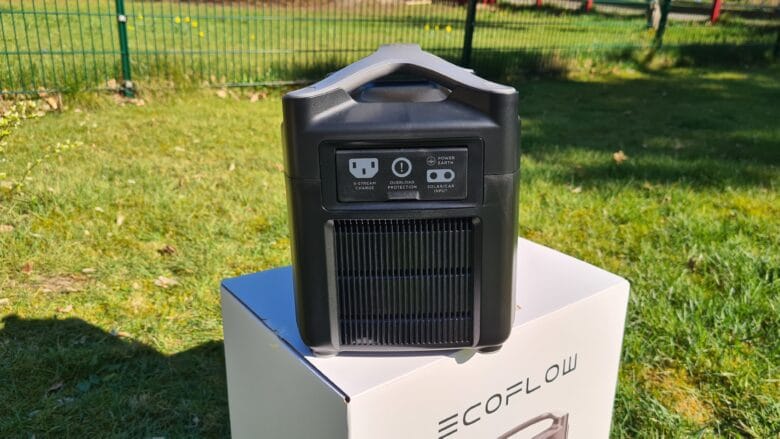
No matter whether camping site, festival site or power supply for the garden. In practice, the River Pro proves to be a reliable power source. Among other things, the power station scores with its Quickcharge feature, but also with its USB-C port, which can output up to 100 watts. While the former ensures a quickly charged smartphone, the USB-C port can be used to charge the notebook. Thus, the home office can be conveniently replicated on the go.

In view of the connection variety, however, the power donor then almost seems underpowered. If you want to expect more from the River Pro, you can simply take your home household with you on vacation – at least in theory. Whether it’s a toaster, coffee maker or even a fridge – you can really connect everything here. It is the portability of the power station that proves to be a great advantage in practice. Here you do not have to lead the device to the power dispenser, but makes the River Pro a mobile socket.
Easy to use and quiet operation
Of course, we also want to take a look at the operability of the power station. A lot can be set on the device itself, but to take advantage of the River Pro’s full range of functions, you should reach for the handy app. We will discuss this in more detail later. We also noticed the quiet operation of the River Pro in practice. The fans were barely audible even when listening closely. There is a small reason to complain for all those who want to use their power station in demanding outdoor areas with rain and dirt. EcoFlow does not provide the River Pro with an IP certification and thus no corresponding protection against damage.
Battery with pleasing service life
EcoFlow relies on a classic lithium ion battery for its River Pro. It is clear that it offers a lot of power. After all, it can be charged from 0 to 80 percent in just one hour. And it can be charged from a conventional household outlet. But what about its staying power? EcoFlow itself promises that the battery can withstand a total of 800 charging cycles until the maximum capacity of the battery is reduced to 80 percent. Of course, we could not verify this. However, if this value proves to be true, then the manufacturer delivers a power station with an above-average battery life. After all, many competitors already reach the magic capacity limit of 80 percent after just under 500 charging cycles.
Full range of functions with practical app
If you want to get the most out of the Powerstation, you should download the matching EcoFlow app. On the one hand, the smartphone application fulfills a very good monitoring function. In addition to temperature and charge level, a glance at the app also clearly reveals the current that is currently flowing into and out of the device. This is especially handy when you want to charge the River Pro for your weekend trip and want to see when the battery is expected to be full.
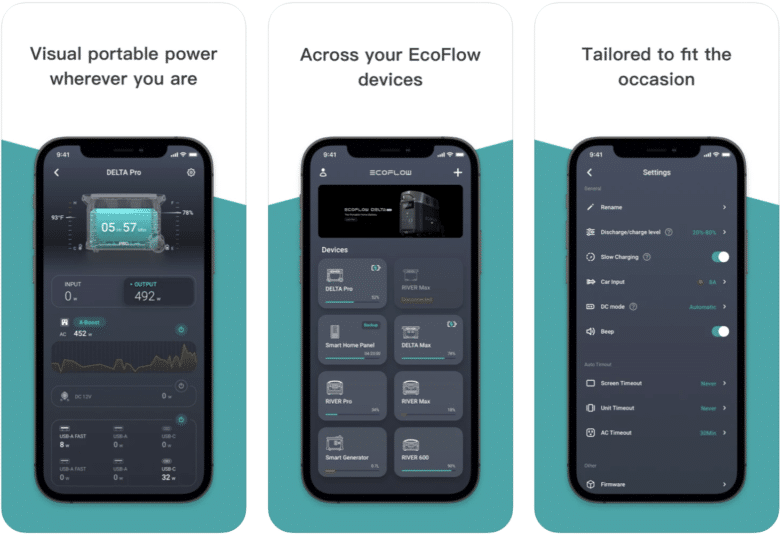
To prevent anyone from drawing unwanted power from the River Pro, the outputs can also be switched on or blocked. No current will then flow through here. The connection between the power station and smartphone is as simple as the app is self-explanatory. Once connected to the WLAN, a foolproof connection can be established between both components.
Independence with solar panel
Optionally to the EcoFlow River Pro one can buy a solar panel fitting to it. This offers the manufacturer optionally with 120 watts or 160 watts of power. For our test, we had the model with 160 watts of power. The combination between the portable power station and the solar panel is really surprisingly good. When the weather is good, it only takes a couple of hours to fully charge the River Pro.
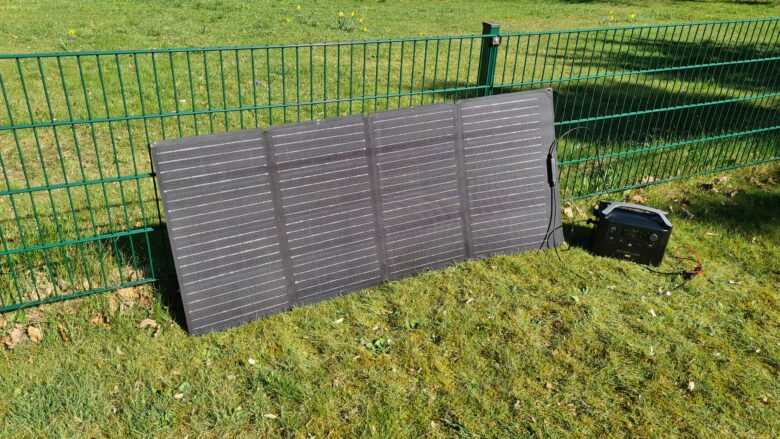
Especially those planning longer trips into the “pampas” should definitely think about buying it. After all, with the help of the panel, you can make yourself independent of external power sources. A very good thing, which is also beneficial to the environment! EcoFlow packages its solar panel similarly well as the power station. A practical goodie here is the separate bag, which you can use not only to transport the panel.

On top of that, it offers a practical added value in that the panels can be set up at the optimal angle of 90 degrees with its help. So that the wind doesn’t become an enemy in the process, EcoFlow also supplies the matching carabiners and eyelets to connect everything together. Once set up, all you have to do is connect the solar panel to the power station.
Conclusion
In testing, EcoFlow proved with its River Pro that the days of power generators with diesel engines are finally over. This is not only supported by the smoke-, odor- and noise-free operation of the River Pro. On top of that, the manufacturer scores with us with a high build quality, which lets us hope that the power station can be enjoyed for many years. On top of that, the power bank’s compact and portable design allows it to be carried from A to B comfortably. Despite the compact design, you don’t have to accept any losses in performance. Quite the contrary. EcoFlow offers everything a good power station should have up its sleeve.
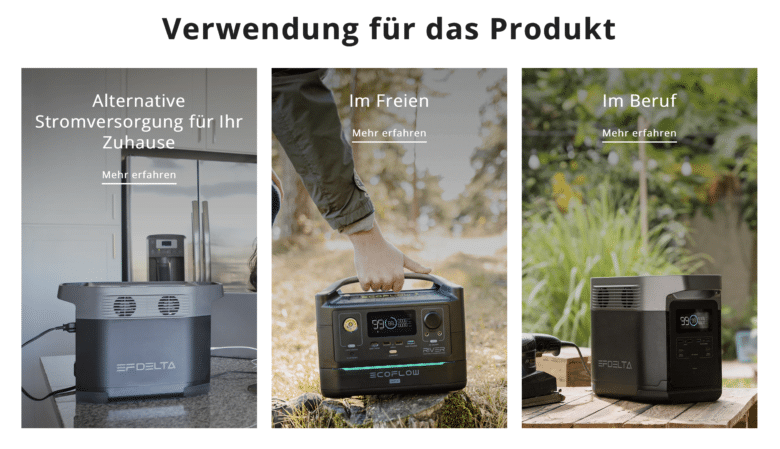
This is already evident with the whopping battery capacity of 720 Wh. I would not have expected so much in view of the small design. The variety of ports is really exciting. Here you can benefit from practical ports like Quick Charge, but also a USB-C port with a proud 100 watts of power. You get the perfect total package when you use the River Pro in combination with the optional solar panel. All in all, EcoFlow delivers the perfect power station for all those who regularly take a weekend trip or are passionate festival goers and don’t want to do without power for their devices.
EcoFlow River Pro
Workmanship
Battery
Performance
Value for money
91/100
With its River Pro, EcoFlow proves how to balance a lot of performance and convenient portability in the best possible way.






